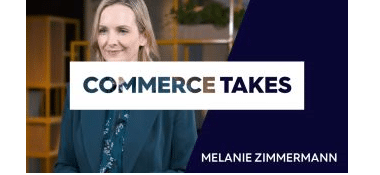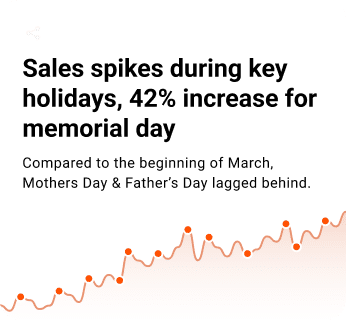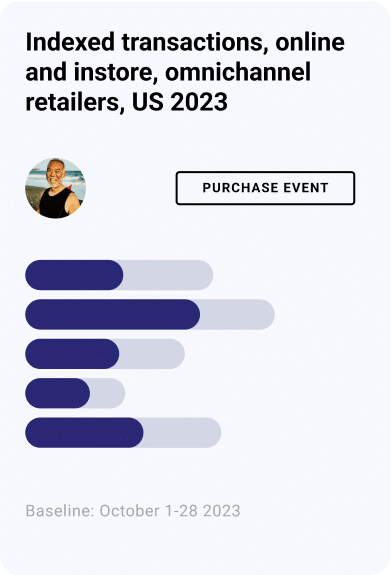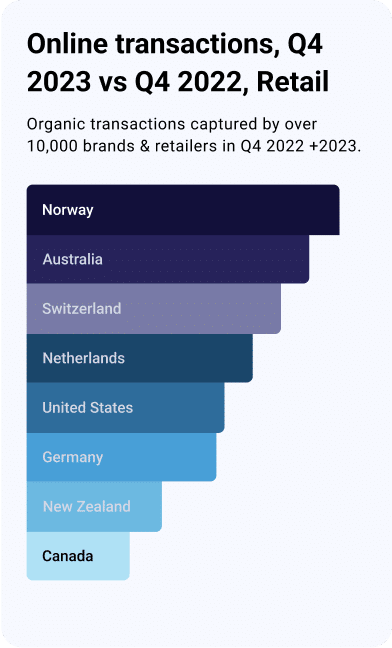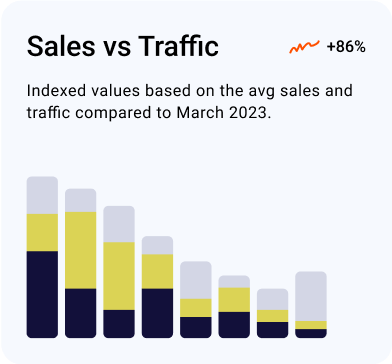Customer Targeting
Customer targeting certainly isn’t new, but the amount of shopper knowledge we have, and the cross-channel shopping journey are changing the game. With the advent of big data and AI, we can understand shopper behavior, predict what they’ll be most interested in, and deliver personalized messages wherever shoppers are on a level that’s never been possible before.
This means that the opportunities for re-engaging your customer base are far greater than ever before, too. If you’re new to customer targeting, or looking to expand your efforts, here are 8 winning strategies for driving more revenue from your customers.
But first, a definition.
What is customer targeting?
customer targeting is the act of identifying and reaching out to a portion of your customer list to re-engage them and drive sales with tailored messages and offers. It involves customizing marketing efforts to address the distinct needs and preferences of individuals or groups with similar characteristics. By analyzing customer demographics, behaviors, and interests, businesses can craft campaigns that resonate on a more personal level. This approach moves away from generic marketing and fosters deeper connections with the audience.
Popular tactics for these campaigns include direct mail and email. Social media and digital ads provide newer avenues to connect with your customer base with more speed and precision.
20 years ago, customer targeting meant sending a direct mail piece to, say, your rewards club members, but now it’s a much more sophisticated effort. The variety of channels on which we can reach customers, and the increasingly detailed data that we can collect about them allows for much smarter customer targeting campaigns, yielding much better results.
Customer targeting is a crucial component of marketing strategy, offering several key advantages when implementing targeted marketing efforts:
- It allows businesses to provide more relevant content and offers, leading to higher engagement and conversion rates.
- It helps build stronger customer relationships by showing that their preferences are understood and valued.
- By reaching the right audience at the right time, customer targeting ensures a more efficient use of advertising spend, reducing waste and improving return on investment (ROI).
How to understand your target customers
Successful marketing relies on a deep understanding of your target customers. By gaining insight into their preferences, behaviors, and needs, you can fine-tune your strategies for better engagement.
- Market research is fundamental to identifying your ideal customers. It involves collecting information about your industry, competitors, and prospective customers. Tools like surveys, focus groups, and interviews provide data on customer needs, interests, and challenges.
- Segmenting your audience through demographic, psychographic, and behavioral criteria is a highly effective approach. Demographic segmentation groups customers by age, gender, income, or location, while psychographic segmentation focuses on their attitudes, values, and lifestyles. Behavioral segmentation looks at actions such as purchasing habits, brand loyalty, and usage patterns.
- Data analytics is another powerful tool for understanding customer preferences. By analyzing data from sources like website traffic, social media metrics, and customer surveys, you can uncover important insights about your audience. This information helps you identify trends, understand preferences, and fine-tune your marketing efforts.
Customer targeting challenges
Even with today’s advanced technology and greater digital opportunity, there are still many challenges to running a successful customer targeting campaign, including:
- Low email response rates. Email open rates are around 20% and drive an average of 2% CTR. This means that 80% of the time, your email is ignored. Despite this, email is an effective re-engagement channel that delivers great ROI—but it’s best used in conjunction with other tactics.
- Low match rates. Many of the existing customer targeting solutions have insufficient or inaccurate identity graphs, and/or have issues successfully matching shoppers across devices. This leads to low match rates (how many of your CRM customers are identified online) and, therefore, a smaller audience to re-engage.
- Limited inventory reach. Solutions are often limited to the reach of their own network, but shoppers are spending significant amounts of their time online outside of places like social media and search engines. Reaching more shoppers in more places means adding additional solutions.
- Limited creative optimization. In some cases, there is a limited amount of creative formats available, or an inability to dynamically personalize creative, which can hurt ad engagement rates.
- Manual campaign set up. Some customer targeting solutions require heavy manual effort, from set up through analysis and optimization. This means that brands and retailers are spending inordinate amounts of time without a guarantee of improved results.
8 proven customer targeting strategies:
Let’s get down to why you’re here: customer targeting strategies. The number and type of customer targeting campaigns you can run really depends on how you slice and dice your CRM data. But here are some tried-and-true strategies:
- Re-engage lapsed shoppers with top sellers. Reach lapsed customers using their last purchase date, and segment as you see fit (i.e. 6, 12, or 24 months). Bring them back to buy with ads featuring your top sellers.
- Connect with seasonal buyers. Reach your seasonal buyers when they’re most likely to convert using recurring campaigns. Boost customer engagement by targeting them with timely offers during seasonal sales periods. That customer who bought earrings for Valentine’s Day last year? Maybe a personalized ad showing a matching bracelet is what’ll get him to return to your site.
- Bring offline buyers, online. In many cases, a shopper’s first or only touchpoint is with your brick-and-mortar store. A customer targeting campaign can drive premium offline audiences online by offering personalized product recommendations and special promotional codes to entice them visit your website.
- Target loyalty program members. Boost brand engagement and drive product sales using paid display promotions that target premium/gold members with exclusive offers based on their last purchase date. You can also drive loyalty program sign-ups by targeting customers who haven’t joined the program yet. Think about segmenting your database based on the total value of their last purchase. Target highly valued customers with similar products, rather than looking to mass target your entire database
- Upsell based on a previous purchase. Reconnect with your existing customers by reaching out with offers for accessories related to an item they previously bought, like a case or headphones, or service or warranty packages to go with the laptop they bought a few days ago,
- Cross-sell based on a previous purchase. Don’t forget to also reach out to previous buyers with offers for other products they might be interested in, like a tablet or smart speaker for the customer who bought a laptop a few months ago.
- Communicate new products. Your frequent buyers are your best candidates for purchasing again. Be sure to hit this group with offers promoting new products.
- Upgrade to a newer/better product. Boost new product sales by connecting with customers who’ve purchased a product that now has a newer or better version available.
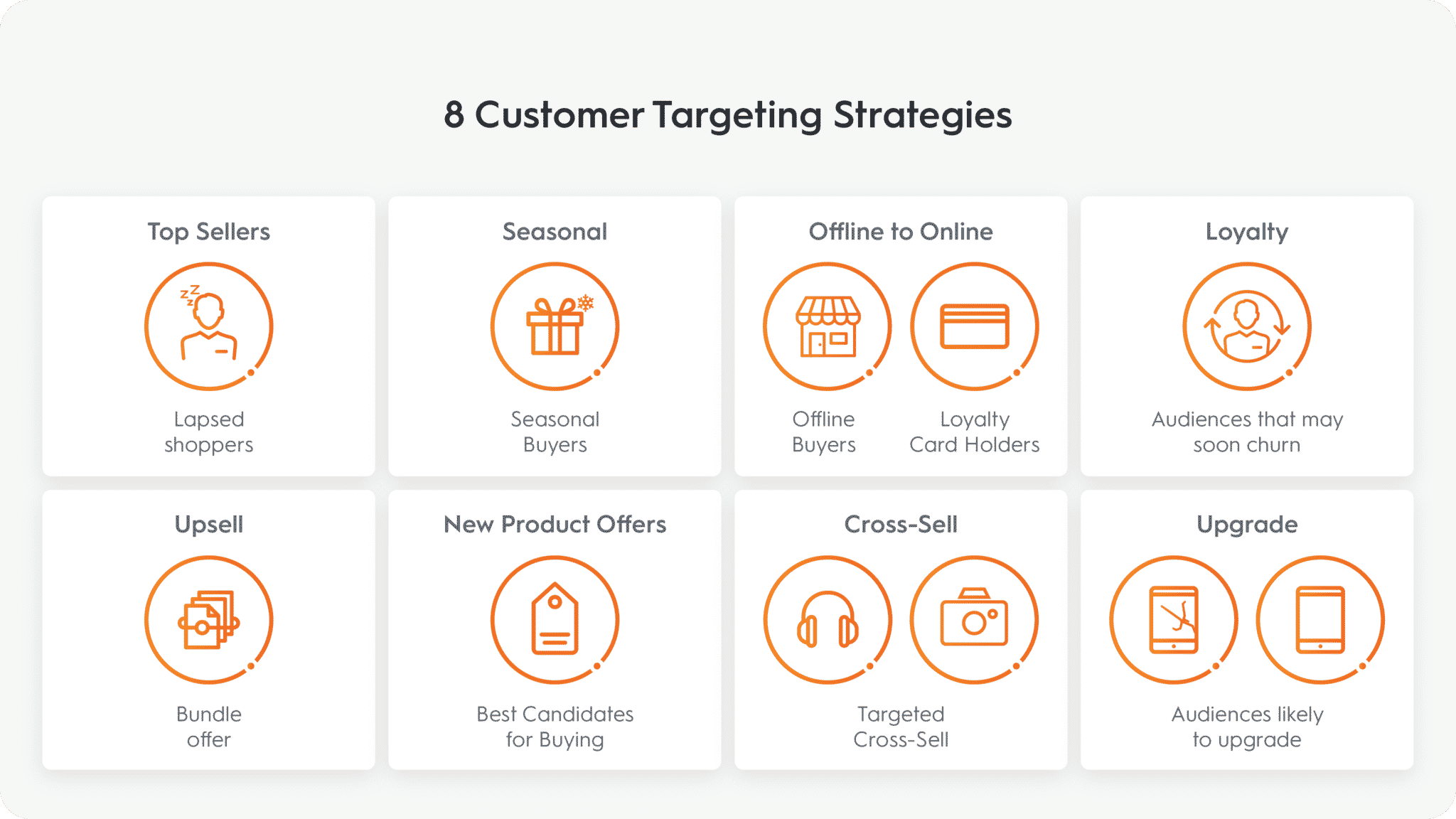
Tips for finding the right customer targeting partner:
With the right mix of strategies and solutions, brands and retailers can overcome the challenges associated with customer targeting. If your current customer targeting efforts aren’t delivering the performance you need, look for a solution that offers:
- Broad reach, beyond walled gardens. Some of today’s customer targeting solutions operate within walled gardens, which means that you’re only able to target shoppers within that garden. This limits your reach and leads to an incomplete view of shopper behavior. Supplement your efforts with a solution that can connect with shoppers beyond those gardens, wherever they are in their browsing journey.
- Strong match rates. Online customer targeting is only as good as the number of your customers that you can identify and match across devices. If you’re not seeing a match rate around 60% or better, you’re missing out.
- No data onboarding fees. Data onboarding can be costly, but there are plenty of solutions that don’t charge for this.
- Dynamic, personalized ads. Improve ad engagement with a solution that delivers ads that are personalized and dynamically optimized for each shopper.


